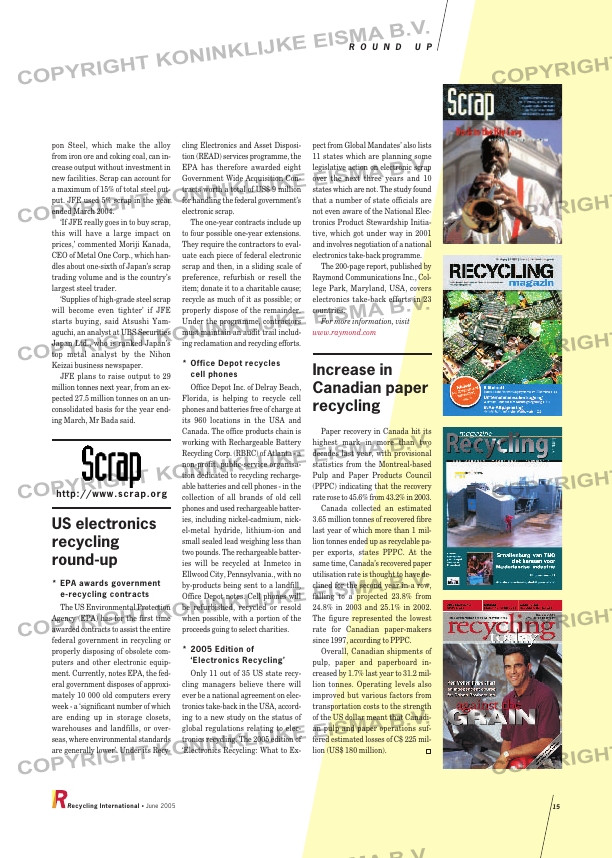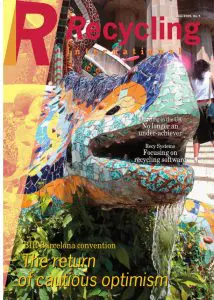Page 15 from: June 2005

pon Steel, which make the alloy
from iron ore and coking coal, can in-
crease output without investment in
new facilities. Scrap can account for
a maximum of 15% of total steel out-
put. JFE used 5% scrap in the year
ended March 2004.
‘If JFE really goes in to buy scrap,
this will have a large impact on
prices,’ commented Moriji Kanada,
CEO of Metal One Corp., which han-
dles about one-sixth of Japan’s scrap
trading volume and is the country’s
largest steel trader.
‘Supplies of high-grade steel scrap
will become even tighter’ if JFE
starts buying, said Atsushi Yam-
aguchi, an analyst at UBS Securities
Japan Ltd., who is ranked Japan’s
top metal analyst by the Nihon
Keizai business newspaper.
JFE plans to raise output to 29
million tonnes next year, from an ex-
pected 27.5 million tonnes on an un-
consolidated basis for the year end-
ing March, Mr Bada said.
US electronics
recycling
round-up
* EPA awards government
e-recycling contracts
The US Environmental Protection
Agency (EPA) has for the first time
awarded contracts to assist the entire
federal government in recycling or
properly disposing of obsolete com-
puters and other electronic equip-
ment. Currently, notes EPA, the fed-
eral government disposes of approxi-
mately 10 000 old computers every
week – a ‘significant number of which
are ending up in storage closets,
warehouses and landfills, or over-
seas, where environmental standards
are generally lower’. Under its Recy-
cling Electronics and Asset Disposi-
tion (READ) services programme, the
EPA has therefore awarded eight
Government Wide Acquisition Con-
tracts worth a total of US$ 9 million
for handling the federal government’s
electronic scrap.
The one-year contracts include up
to four possible one-year extensions.
They require the contractors to eval-
uate each piece of federal electronic
scrap and then, in a sliding scale of
preference, refurbish or resell the
item; donate it to a charitable cause;
recycle as much of it as possible; or
properly dispose of the remainder.
Under the programme, contractors
must maintain an audit trail includ-
ing reclamation and recycling efforts.
* Office Depot recycles
cell phones
Office Depot Inc. of Delray Beach,
Florida, is helping to recycle cell
phones and batteries free of charge at
its 960 locations in the USA and
Canada. The office products chain is
working with Rechargeable Battery
Recycling Corp. (RBRC) of Atlanta – a
non-profit, public-service organisa-
tion dedicated to recycling recharge-
able batteries and cell phones – in the
collection of all brands of old cell
phones and used rechargeable batter-
ies, including nickel-cadmium, nick-
el-metal hydride, lithium-ion and
small sealed lead weighing less than
two pounds. The rechargeable batter-
ies will be recycled at Inmetco in
Ellwood City, Pennsylvania., with no
by-products being sent to a landfill,
Office Depot notes. Cell phones will
be refurbished, recycled or resold
when possible, with a portion of the
proceeds going to select charities.
* 2005 Edition of
‘Electronics Recycling’
Only 11 out of 35 US state recy-
cling managers believe there will
ever be a national agreement on elec-
tronics take-back in the USA, accord-
ing to a new study on the status of
global regulations relating to elec-
tronics recycling. The 2005 edition of
‘Electronics Recycling: What to Ex-
pect from Global Mandates’ also lists
11 states which are planning some
legislative action on electronic scrap
over the next three years and 10
states which are not. The study found
that a number of state officials are
not even aware of the National Elec-
tronics Product Stewardship Initia-
tive, which got under way in 2001
and involves negotiation of a national
electronics take-back programme.
The 200-page report, published by
Raymond Communications Inc., Col-
lege Park, Maryland, USA, covers
electronics take-back efforts in 23
countries.
For more information, visit
www.raymond.com
Increase in
Canadian paper
recycling
Paper recovery in Canada hit its
highest mark in more than two
decades last year, with provisional
statistics from the Montreal-based
Pulp and Paper Products Council
(PPPC) indicating that the recovery
rate rose to 45.6% from 43.2% in 2003.
Canada collected an estimated
3.65 million tonnes of recovered fibre
last year of which more than 1 mil-
lion tonnes ended up as recyclable pa-
per exports, states PPPC. At the
same time, Canada’s recovered paper
utilisation rate is thought to have de-
clined for the second year in a row,
falling to a projected 23.8% from
24.8% in 2003 and 25.1% in 2002.
The figure represented the lowest
rate for Canadian paper-makers
since 1997, according to PPPC.
Overall, Canadian shipments of
pulp, paper and paperboard in-
creased by 1.7% last year to 31.2 mil-
lion tonnes. Operating levels also
improved but various factors from
transportation costs to the strength
of the US dollar meant that Canadi-
an pulp and paper operations suf-
fered estimated losses of C$ 225 mil-
lion (US$ 180 million).
R O U N D U P
https://www.scrap.org
Recycling International • June 2005 15



